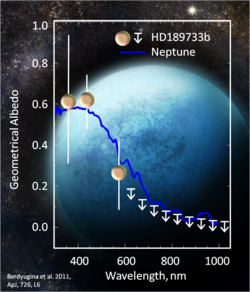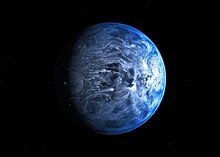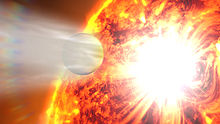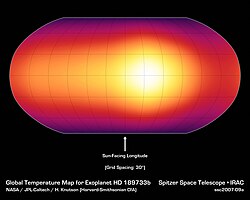astro.wikisort.org - Meteorite
HD 189733 b is an exoplanet approximately 64.5 light-years (19.8 pc) away[3] from the Solar System in the constellation of Vulpecula. Astronomers in France discovered the planet orbiting the star HD 189733 on October 5, 2005, by observing its transit across the star's face.[1] With a mass 16.2% higher than that of Jupiter and a radius 13.8% greater, HD 189733 b orbits its host star once every 2.2 days at an orbital speed of 152.5 kilometers per second (152,500 meters per second; 341,100 miles per hour), making it a hot Jupiter with poor prospects for extraterrestrial life.
 Size comparison of Jupiter with HD 189733 b. | |
| Discovery[1] | |
|---|---|
| Discovered by | Bouchy et al. |
| Discovery site | Haute-Provence Observatory |
| Discovery date | October 5, 2005 |
Detection method | Doppler spectroscopy Transit |
| Orbital characteristics | |
| Apastron | 0.03102 AU (4,641,000 km) |
| Periastron | 0.03096 AU (4,632,000 km) |
Semi-major axis | 0.03099 ± 0.0006 AU (4,636,000 ± 90,000 km) |
| Eccentricity | 0.0010 ± 0.0002 |
Orbital period (sidereal) | 2.2185733 ± 0.00002 d 53.245759 h |
Average orbital speed | 152.5 |
| Inclination | 85.76 ± 0.29 |
| Semi-amplitude | 205 ± 6 |
| Star | HD 189733 |
| Physical characteristics | |
Mean radius | 1.138 ± 0.027 RJ |
| Mass | 1.162+0.058 −0.039[2] MJ |
Surface gravity | 21.2 m/s2 (70 ft/s2) |
| Albedo | 0.40 ± 0.12 (290–450 nm) < 0.12 (450–570 nm) |
| Temperature | 1117 ± 42 K |
The closest transiting hot Jupiter to Earth, HD 189733 b is a subject of extensive atmospheric examination. Accordingly, scientists have extensively studied the exoplanet's atmosphere with high- and low-resolution instruments, both from the ground and space.[4] As a result,we discovered the planet had an unusual rain of molten glass. HD 188733 b was also the first exoplanet to have its thermal map constructed (possibly to be detected through polarimetry),[5] its overall color determined (deep blue),[5][6] transit in the X-ray spectrum, and carbon dioxide confirmed in its atmosphere.
In July 2014, NASA announced finding very dry atmospheres on three exoplanets (HD 189733b, HD 209458b, WASP-12b) orbiting Sun-like stars.[7]
Detection and discovery
Transit and Doppler spectroscopy

On October 6, 2005, a team of astronomers announced the discovery of transiting planet HD 189733 b. The planet was then detected using Doppler spectroscopy. Real-time radial velocity measurements detected the Rossiter–McLaughlin effect caused by the planet passing in front of its star before photometric measurements confirmed that the planet was transiting.[1] In 2006, a team led by Drake Deming announced detection of strong infrared thermal emission from the transiting exoplanet planet HD 189733 b, by measuring the flux decrement (decrease of total light) during its prominent secondary eclipse (when the planet passes behind the star).
The mass of the planet is estimated to be 16% larger than Jupiter's, with the planet completing an orbit around its host star every 2.2 days and an orbital speed of 152.5 kilometres per second (341,000 mph).
Infrared spectrum
On February 21, 2007, NASA released news that the Spitzer Space Telescope had measured detailed spectra from both HD 189733 b and HD 209458 b.[8] The release came simultaneously with the public release of a new issue of Nature containing the first publication on the spectroscopic observation of the other exoplanet, HD 209458 b. A paper was submitted and published by the Astrophysical Journal Letters. The spectroscopic observations of HD 189733 b were led by Carl Grillmair of NASA's Spitzer Science Center.
Visible color
In 2008, a team of astrophysicists appeared to have detected and monitored the planet's visible light using polarimetry, which would have been the first such success.[9] This result seemed to be confirmed and refined by the same team in 2011.[5] They found that the planet albedo is significantly larger in blue light than in the red, most probably due to Rayleigh scattering and molecular absorption in the red.[5] The blue color of the planet was subsequently confirmed in 2013,[10] which would have made HD 189733 the first planet to have its overall color determined by two different techniques. These measurements in polarized light have since been disputed by two separate teams using more sensitive polarimeters,[11][12][13] with upper limits of the polarimetric signal provided therein.
The blueness of the planet may be the result of Rayleigh scattering. In mid January 2008, spectral observation during the planet's transit using that model found that if molecular hydrogen exists, it would have an atmospheric pressure of 410 ± 30 mbar of 0.1564 solar radii. The Mie approximation model also found that there is a possible condensate in its atmosphere, magnesium silicate (MgSiO3) with a particle size of approximately 10−2 to 10−1 μm. Using both models, the planet's temperature would be between 1340 and 1540 K.[14] The Rayleigh effect is confirmed in other models,[15] and by the apparent lack of a cooler, shaded stratosphere below its outer atmosphere. In the visible region of the spectrum, thanks to their high absorption cross sections, atomic sodium and potassium can be investigated. For example, using high-resolution UVES spectrograph on VLT, sodium has been detected on this atmosphere and further physical characteristics of the atmosphere such as temperature has been investigated.[4]
X-ray spectrum
In July 2013, NASA reported the first observations of planet transit studied in the X-ray spectrum. It was found that the planet's atmosphere blocks three times more X-rays than visible light.[16]
Evaporation
In March 2010, transit observations using HI Lyman-alpha found that this planet is evaporating at a rate of 1-100 gigagrams per second. This indication was found by detecting the extended exosphere of atomic hydrogen. HD 189733 b is the second planet after HD 209458 b for which atmospheric evaporation has been detected.[17]
Physical characteristics
This planet exhibits one of the largest photometric transit depth (amount of the parent star's light blocked) of extrasolar planets so far observed, approximately 3%. The apparent longitude of ascending node of its orbit is 16 degrees +/- 8 away from the north–south in our sky. It and HD 209458 b were the first two planets to be directly spectroscopically observed.[8] The parent stars of these two planets are the brightest transiting-planet host stars, so these planets will continue to receive the most attention from astronomers. Like most hot Jupiters, this planet is thought to be tidally locked to its parent star, meaning it has a permanent day and night.
The planet is not oblate, and has neither satellites with greater than 0.8 the radius of Earth nor a ring system like that of Saturn.[18]
The international team under the direction of Svetlana Berdyugina of Zurich University of Technology, using the Swedish 60-centimeter telescope KVA, which is located in Spain, was able to directly see the polarized light reflected from the planet. The polarization indicates that the scattering atmosphere is considerably larger (> 30%) than the opaque body of the planet seen during transits.[19]
The atmosphere was at first predicted "pL class", lacking a temperature-inversion stratosphere; like L dwarfs which lack titanium and vanadium oxides.[20] Follow-up measurements, tested against a stratospheric model, yielded inconclusive results.[21] Atmospheric condensates form a haze 1,000 kilometres (620 mi) above the surface as viewed in the infrared. A sunset viewed from that surface would be red.[22] Sodium and potassium signals were predicted by Tinetti 2007. First obscured by the haze of condensates, sodium was eventually observed at three times the concentration of HD 209458 b's sodium layer.[23] The potassium was also detected in 2020, although in significantly smaller concentrations.[24] HD 189733 is also the first extrasolar planet confirmed to have carbon dioxide in its atmosphere.[25]
Map of the planet

In 2007, the Spitzer Space Telescope was used to map the planet's temperature emissions. The planet+star system was observed for 33 consecutive hours, starting when only the night side of the planet was in view. Over the course of one-half of the planet's orbit, more and more of the dayside came into view. A temperature range of 973 ± 33 K to 1,212 ± 11 K was discovered, indicating that the absorbed energy from the parent star is distributed fairly evenly through the planet's atmosphere. The region of peak temperature was offset 30 degrees east of the substellar point, as predicted by theoretical models of hot Jupiters taking into account a parameterized day to night redistribution mechanism.[26]

Scientists at the University of Warwick determined that it has winds of up to 8,700 km/h (5,400 mph) blowing from the day side to the night side.[27] NASA released a brightness map of the surface temperature of HD 189733 b; it is the first map ever published of an extra-solar planet.[28]
Water vapor, oxygen, and organic compounds
On July 11, 2007, a team led by Giovanna Tinetti published the results of their observations using the Spitzer Space Telescope concluding there is solid evidence for significant amounts of water vapor in the planet's atmosphere.[29] Follow-up observations made using the Hubble Space Telescope confirm the presence of water vapor, neutral oxygen and also the organic compound methane.[15][30][31] Later, Very Large Telescope observations also detected the presence of carbon monoxide on the day side of the planet.[2] It is currently unknown how the methane originated as the planet's high 700 °C temperature should cause the water and methane to react, replacing the atmosphere with carbon monoxide.[30][32] Nonetheless, the presence of roughly 0.004% of water vapour fraction by volume in atmosphere of HD 189733 b was confirmed with high-resolution emission spectra taken in 2021.[33]
Weather and rains of molten glass

The weather on HD 189733b is deadly. The winds, composed of silicate particles, blow up to 8,700 kilometres per hour (5,400 mph). Observations of this planet have also found evidence that it rains molten glass, horizontally.[34]
Evolution
While transiting the system also clearly exhibits the Rossiter–McLaughlin effect, shifting in photospheric spectral lines caused by the planet occulting a part of the rotating stellar surface. Due to its high mass and close orbit, the parent star has a very large semi-amplitude (K), the "wobble" in the star's radial velocity, of 205 m/s.[35]
The Rossiter–McLaughlin effect allows the measurement of the angle between the planet's orbital plane and the equatorial plane of the star. These are well aligned,[36] misalignment equal to -0.5±0.4°.[37] By analogy with HD 149026 b, the formation of the planet was peaceful and probably involved interactions with the protoplanetary disc. A much larger angle would have suggested a violent interplay with other protoplanets.

From top left to lower right: WASP-12b, WASP-6b, WASP-31b, WASP-39b, HD 189733b, HAT-P-12b, WASP-17b, WASP-19b, HAT-P-1b and HD 209458b.
Star-planet interaction controversy
In 2008, a team of astronomers first described how as the exoplanet orbiting HD 189733 A reaches a certain place in its orbit, it causes increased stellar flaring. In 2010, a different team found that every time they observe the exoplanet at a certain position in its orbit, they also detected X-ray flares. Theoretical research since 2000 suggested that an exoplanet very near to the star that it orbits may cause increased flaring due to the interaction of their magnetic fields, or because of tidal forces. In 2019, astronomers analyzed data from Arecibo Observatory, MOST, and the Automated Photoelectric Telescope, in addition to historical observations of the star at radio, optical, ultraviolet, and X-ray wavelengths to examine these claims. They found that the previous claims were exaggerated and the host star failed to display many of the brightness and spectral characteristics associated with stellar flaring and solar active regions, including sunspots. Their statistical analysis also found that many stellar flares are seen regardless of the position of the exoplanet, therefore debunking the earlier claims. The magnetic fields of the host star and exoplanet do not interact, and this system is no longer believed to have a "star-planet interaction."[38] Some researchers had also suggested that HD 189733 accretes, or pulls, gas from its orbiting exoplanet at a rate similar to those found around young protostars in T Tauri Star systems. Later analysis demonstrated that very little, if any, gas was accreted from the "hot Jupiter" companion.[39]
See also
- Dimidium "Bellerophon" (51 Pegasi b - HD 217014 b)
- HD 2039 b
- HD 149026 b
- Kepler-186 f
- Osiris (HD 209458 b)
- WASP-3 b
- WASP-12 b
- WASP-189 b
References
- Bouchy, F.; et al. (2005). "ELODIE metallicity-biased search for transiting Hot Jupiters II. A very hot Jupiter transiting the bright K star HD 189733". Astronomy and Astrophysics. 444 (1): L15–L19. arXiv:astro-ph/0510119. Bibcode:2005A&A...444L..15B. doi:10.1051/0004-6361:200500201.
- de Kok, R. J.; et al. (2013). "Detection of carbon monoxide in the high-resolution day-side spectrum of the exoplanet HD 189733b". Astronomy and Astrophysics. 554. A82. arXiv:1304.4014. Bibcode:2013A&A...554A..82D. doi:10.1051/0004-6361/201321381. S2CID 55266595.
- Brown, A. G. A.; et al. (Gaia collaboration) (August 2018). "Gaia Data Release 2: Summary of the contents and survey properties". Astronomy & Astrophysics. 616. A1. arXiv:1804.09365. Bibcode:2018A&A...616A...1G. doi:10.1051/0004-6361/201833051. Gaia DR2 record for this source at VizieR.
- Khalafinejad, S.; Essen, C. von; Hoeijmakers, H. J.; Zhou, G.; Klocová, T.; Schmitt, J. H. M. M.; Dreizler, S.; Lopez-Morales, M.; Husser, T.-O. (2017-02-01). "Exoplanetary atmospheric sodium revealed by orbital motion". Astronomy & Astrophysics. 598: A131. arXiv:1610.01610. Bibcode:2017A&A...598A.131K. doi:10.1051/0004-6361/201629473. ISSN 0004-6361. S2CID 55263138.
- Berdyugina, S.V.; Berdyugin, A.V.; Fluri, D.M.; Piirola, V. (2011). "Polarized reflected light from the exoplanet HD189733b: First multicolor observations and confirmation of detection". Astrophysical Journal Letters. 726 (1): L6–L9. arXiv:1101.0059. Bibcode:2011ApJ...728L...6B. doi:10.1088/2041-8205/728/1/L6. S2CID 59160192.
- Kramer, Miriam (11 July 2013). "Strange Blue World: Alien Planet's True Color Revealed, a First". Space.com. TechMediaNetwork. Retrieved 11 July 2013.
- Harrington, J.D.; Villard, Ray (July 24, 2014). "RELEASE 14-197 - Hubble Finds Three Surprisingly Dry Exoplanets". NASA. Retrieved July 25, 2014.
- "Press Release: NASA's Spitzer First To Crack Open Light of Faraway Worlds". Archived from the original on July 15, 2007.
- Berdyugina, Svetlana V.; Andrei V. Berdyugin; Dominique M. Fluri; Vilppu Piirola (20 January 2008). "First detection of polarized scattered light from an exoplanetary atmosphere". The Astrophysical Journal. 673 (1): L83–L86. arXiv:0712.0193. Bibcode:2008ApJ...673L..83B. doi:10.1086/527320. S2CID 14366978.
- Powell, Devin (July 11, 2013). "First distant planet to be seen in colour is blue". Nature. doi:10.1038/nature.2013.13376. S2CID 130070356 – via www.nature.com.
- Wiktorowicz, Sloane J. (2009-04-22). "NONDETECTION OF POLARIZED, SCATTERED LIGHT FROM THE HD 189733b HOT JUPITER". The Astrophysical Journal. 696 (2): 1116–1124. arXiv:0902.0624. Bibcode:2009ApJ...696.1116W. doi:10.1088/0004-637X/696/2/1116. ISSN 0004-637X. S2CID 11384636.
- Wiktorowicz, Sloane J.; Nofi, Larissa A.; Jontof-Hutter, Daniel; Kopparla, Pushkar; Laughlin, Gregory P.; Hermis, Ninos; Yung, Yuk L.; Swain, Mark R. (2015-10-27). "A GROUND-BASED ALBEDO UPPER LIMIT FOR HD 189733b FROM POLARIMETRY". The Astrophysical Journal. 813 (1): 48. arXiv:1507.03588. Bibcode:2015ApJ...813...48W. doi:10.1088/0004-637X/813/1/48. ISSN 1538-4357. S2CID 118086125.
- Bott, Kimberly; Bailey, Jeremy; Kedziora-Chudczer, Lucyna; Cotton, Daniel V.; Lucas, P. W.; Marshall, Jonathan P.; Hough, J. H. (2016-03-20). "The polarization of HD 189733" (PDF). Monthly Notices of the Royal Astronomical Society: Letters. 459 (1): L109–L113. Bibcode:2016MNRAS.459L.109B. doi:10.1093/mnrasl/slw046. ISSN 1745-3925.
- A. Lecavelier des Etangs; F. Pont; A. Vidal-Madjar; D. Sing (2008). "Rayleigh scattering in the transit spectrum of HD 189733b". Astronomy & Astrophysics. 481 (2): L83–L86. arXiv:0802.3228. Bibcode:2008A&A...481L..83L. doi:10.1051/0004-6361:200809388. S2CID 18738916. Retrieved 2008-08-08.
- Eric Agol; et al. (2008). "Transits and secondary eclipses of HD 189733 with Spitzer". Proceedings of the International Astronomical Union. 4: 209–215. arXiv:0807.2434. doi:10.1017/S1743921308026422. S2CID 15867430.
- Boen, Brooke (May 20, 2015). "NASA's Chandra Sees Eclipsing Planet in X-rays for First Time". NASA.
- Lecavelier des Etangs; et al. (2010-03-10). "Evaporation of the planet HD189733b observed in HI Lyman-alpha" (PDF). Astronomy & Astrophysics. 1003: 2206. arXiv:1003.2206. Bibcode:2010A&A...514A..72L. doi:10.1051/0004-6361/200913347. S2CID 53408874.
- Frédéric Pont; et al. (2008). "Hubble Space Telescope time-series photometry of the planetary transit of HD189733: no moon, no rings, starspots". Astronomy and Astrophysics. 476 (3): 1347–1355. arXiv:0707.1940. Bibcode:2007A&A...476.1347P. doi:10.1051/0004-6361:20078269. S2CID 18293269.
- Polarization technique focuses limelight, 12/26/2007
- Fortney, J. J.; Lodders, K.; Marley, M. S.; Freedman, R. S. (2008). "A Unified Theory for the Atmospheres of the Hot and Very Hot Jupiters: Two Classes of Irradiated Atmospheres". Astrophysical Journal. 678 (2): 1419–1435. arXiv:0710.2558. Bibcode:2008ApJ...678.1419F. doi:10.1086/528370. S2CID 17502177.
- Ivan Hubeny; Adam Burrows (2008). "Spectrum and atmosphere models of irradiated transiting extrasolar giant planets". Proceedings of the International Astronomical Union. 4: 239–245. arXiv:0807.3588. Bibcode:2009IAUS..253..239H. doi:10.1017/S1743921308026458. S2CID 13978248.
- F. Pont; et al. (2008). "Detection of atmospheric haze on an extrasolar planet: The 0.55 – 1.05 micron transmission spectrum of HD189733b with the Hubble Space Telescope". Monthly Notices of the Royal Astronomical Society. 385 (1): 109–118. arXiv:0712.1374. Bibcode:2008MNRAS.385..109P. doi:10.1111/j.1365-2966.2008.12852.x. S2CID 10831981.
- Redfield; Endl, Michael; Cochran, William D.; Koesterke, Lars (2008). "Sodium Absorption from the Exoplanetary Atmosphere of HD 189733b Detected in the Optical Transmission Spectrum". The Astrophysical Journal Letters. 673 (1): L87–L90. arXiv:0712.0761. Bibcode:2008ApJ...673L..87R. doi:10.1086/527475. S2CID 2028887.
- Keles, E.; Kitzmann, D.; Mallonn, M.; Alexoudi, X.; Fossati, L.; Pino, L.; Seidel, J. V.; Carroll, T. A.; Steffen, M.; Ilyin, I.; Poppenhäger, K.; Strassmeier, K. G.; Von Essen, C.; Nascimbeni, V.; Turner, J. D. (2020), "Probing the atmosphere of HD189733b with the Na i and K i lines", Monthly Notices of the Royal Astronomical Society, 498: 1023–1033, arXiv:2008.04044, doi:10.1093/mnras/staa2435
- Robert Roy Britt (November 24, 2008). "Carbon Dioxide Detected on Faraway World". Space.com.
- Iro, Nicolas; Bruno Bezard; T. Guillot (June 2005). "A time-dependent radiative model of HD 209458b". Astronomy and Astrophysics. 436 (2): 719–727. arXiv:astro-ph/0409468. Bibcode:2005A&A...436..719I. doi:10.1051/0004-6361:20048344. S2CID 14132527.
- Klotz, Irene (November 16, 2015). "Exoplanet's Global Winds Let Rip at 5,400 MPH". Space. Retrieved 2015-11-17.
- "First Map of Alien World". Spitzer Space Telescope. Jet Propulsion Laboratory. 2007-05-09. Retrieved 2009-09-30.
- "Press Release: NASA's Spitzer Finds Water Vapor on Hot, Alien Planet".
- Swain, Mark R.; Vasisht, Gautam; Tinetti, Giovanna (2008-03-20). "The presence of methane in the atmosphere of an extrasolar planet". Nature. 452 (7185): 329–331. Bibcode:2008Natur.452..329S. doi:10.1038/nature06823. PMID 18354477. S2CID 205212651. arXiv.org link
- Ben-Jaffel, Lotfi; Ballester, Gilda (May 18, 2013). "Hubble Space Telescope detection of oxygen in the atmosphere of exoplanet HD189733b". Astronomy & Astrophysics. 553: A52. arXiv:1303.4232. Bibcode:2013A&A...553A..52B. doi:10.1051/0004-6361/201221014. S2CID 119311496 – via arXiv.org.
- Stephen Battersby (2008-02-11). "Organic molecules found on alien world for first time". Retrieved 2008-02-12.
- Boucher, Anne; et al. (9 November 2021). "Characterizing Exoplanetary Atmospheres at High Resolution with SPIRou: Detection of Water on HD 189733 b". The Astronomical Journal. 162 (6). 233. arXiv:2108.08390. Bibcode:2021AJ....162..233B. doi:10.3847/1538-3881/ac1f8e.
- Loff, Sarah (2016-10-31). "Rains of Terror on Exoplanet HD 189733b". NASA. Retrieved 2019-12-13.
- "HD 189733 page". University of Geneva. 2007-03-05. Retrieved 2008-02-18.
- Gregory W. Henry; et al. (2008). "The Rotation Period of the Planet-Hosting Star HD 189733". The Astronomical Journal. 135 (1): 68–71. arXiv:0709.2142. Bibcode:2008AJ....135...68H. doi:10.1088/0004-6256/135/1/68. S2CID 15540915.
- Albrecht, Simon; Winn, Joshua N.; Johnson, John A.; Howard, Andrew W.; Marcy, Geoffrey W.; Butler, R. Paul; Arriagada, Pamela; Crane, Jeffrey D.; Shectman, Stephen A.; Thompson, Ian B.; Hirano, Teruyuki; Bakos, Gaspar; Hartman, Joel D. (2012), "Obliquities of Hot Jupiter Host Stars: Evidence for Tidal Interactions and Primordial Misalignments", The Astrophysical Journal, 757: 18, arXiv:1206.6105, Bibcode:2012ApJ...757...18A, doi:10.1088/0004-637X/757/1/18, S2CID 17174530
- Route, Matthew (February 10, 2019). "The Rise of ROME. I. A Multiwavelength Analysis of the Star-Planet Interaction in the HD 189733 System". The Astrophysical Journal. 872 (1): 79. arXiv:1901.02048. Bibcode:2019ApJ...872...79R. doi:10.3847/1538-4357/aafc25. S2CID 119350145.
- Route, Matthew; Looney, Leslie (December 20, 2019). "ROME (Radio Observations of Magnetized Exoplanets). II. HD 189733 Does Not Accrete Significant Material from Its Exoplanet Like a T Tauri Star from a Disk". The Astrophysical Journal. 887 (2): 229. arXiv:1911.08357. Bibcode:2019ApJ...887..229R. doi:10.3847/1538-4357/ab594e. S2CID 208158242.
External links
 Media related to HD 189733 b at Wikimedia Commons
Media related to HD 189733 b at Wikimedia Commons- Berdyugina; Berdyugin; Fluri; Piirola (2008-02-02). "First Detection of Polarized Scattered Light from an Exoplanetary Atmosphere". The Astrophysical Journal. 673 (1): L83–L86. arXiv:0712.0193. Bibcode:2008ApJ...673L..83B. doi:10.1086/527320. S2CID 14366978.
- Naeye, Robert (2005-10-07). "The Best Transiting Exoplanet Yet". Sky & Telescope. Retrieved 2008-06-21.
- Deming; Harrington, Joseph; Seager, Sara; Jeremy Richardson (2006-02-20). "Strong Infrared Emission from the Extrasolar Planet HD189733b". The Astrophysical Journal. 644 (1): 560–564. arXiv:astro-ph/0602443. Bibcode:2006ApJ...644..560D. doi:10.1086/503358. S2CID 14434391.
- HD 189733 b on WikiSky: DSS2, SDSS, GALEX, IRAS, Hydrogen α, X-Ray, Astrophoto, Sky Map, Articles and images
На других языках
[de] HD 189733 b
HD 189733 b ist die Bezeichnung des ersten Exoplaneten, auf dem Methan-Gas nachgewiesen worden ist. Er umkreist den Hauptreihenstern HD 189733, der etwa 64 Lichtjahre von unserem Sonnensystem entfernt ist. Der Planet besitzt weder einen Mond mit einem Radius von mehr als 0,8 Erdradien noch ein Ringsystem wie der Saturn.[4]- [en] HD 189733 b
[ru] HD 189733 A b
HD 189733 A b — экзопланета, ярко-голубой газовый гигант в созвездии Лисички, по размерам сопоставим с Юпитером, обращается вокруг оранжевого карлика HD 189733 A на расстоянии 63 световых года от Солнца[3][4]. Планета была открыта на орбите звезды HD 189733 A 5 октября 2005 года, когда астрономы во Франции наблюдали, как планета движется по диску звезды[5]. Имея массу на 13 % выше, чем у Юпитера, HD 189733 b вращается вокруг родительской звезды каждые 2,2 дня с орбитальной скоростью 152,5 км/с, что делает его горячим юпитером с плохими перспективами для внеземной жизни. Будучи ближайшим транзитным горячим юпитером к Земле, HD 189733 b является предметом всестороннего изучения атмосферы. Атмосфера HD 189733b была тщательно изучена с помощью приборов с высоким и низким разрешением, как с Земли, так и из космоса[6]. HD 189733 b была первой экзопланетой, для которой была построена карта температур, возможно, зафиксированная с помощью поляриметрии[7], для определения её общего цвета (ярко-голубой)[7][8].Другой контент может иметь иную лицензию. Перед использованием материалов сайта WikiSort.org внимательно изучите правила лицензирования конкретных элементов наполнения сайта.
WikiSort.org - проект по пересортировке и дополнению контента Википедии

